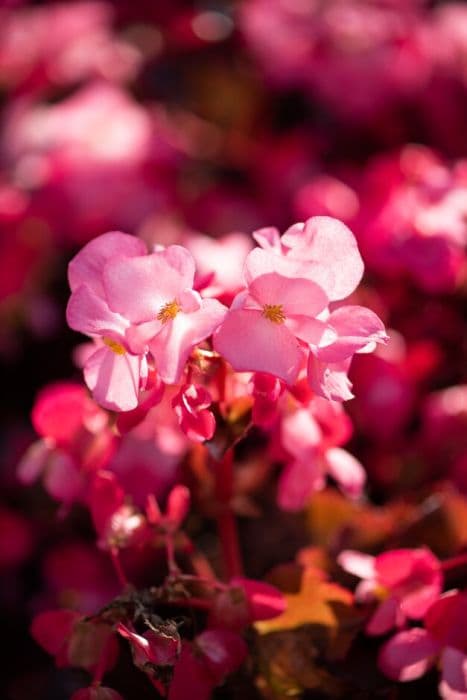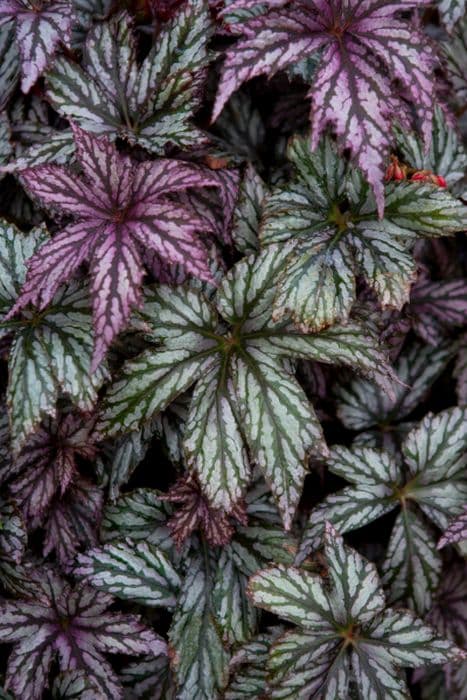Begonia Begonia 'Apricot Shades Improved'

ABOUT
The Begonia 'Apricot Shades Improved' is characterized by its lush green foliage and profusion of vibrant flowers. The leaves are typically glossy and can have a slightly wavy or serrated edge, providing a nice backdrop to the stunning blooms. The begonia flowers themselves are the real showstopper, boasting a harmonious blend of apricot, peach, and salmon hues. Each petal feels delicate and soft, slightly ruffled or smooth, giving the begonias a full, fluffy appearance. The blooms cluster together in abundant cascades that drape gracefully, providing a spectacular display of warm shades that evoke the colors of a sunset. This variety of begonia gives the impression of a continuously flowering bouquet, adding a touch of charm and vibrancy wherever it is placed.
About this plant
 Names
NamesFamily
Begoniaceae.
Synonyms
Begonia, Wax Begonia, Fibrous Begonia.
Common names
Begonia 'Apricot Shades Improved'.
 Toxicity
ToxicityTo humans
Begonias, including the 'Apricot Shades Improved' variety, contain insoluble oxalates which can be mildly toxic when ingested. If parts of the plant are eaten, it can cause irritation in the mouth, lips, tongue, and throat, as well as difficulty in swallowing, and a burning sensation. In more severe cases, there may be vomiting and diarrhea. Generally, the toxicity level is considered low, but it is advisable to avoid consuming any part of the plant.
To pets
For pets, Begonias, such as 'Apricot Shades Improved', are also considered to be mildly toxic. They contain insoluble calcium oxalates which, if ingested, can cause oral irritation, including a burning sensation in the mouth, lips, and tongue. There may also be increased salivation, difficulty swallowing, and vomiting. Rarely, in severe cases, it can lead to more serious symptoms like difficulty breathing or swallowing if swelling occurs. Pet owners should prevent their animals from chewing on or eating any part of the plant.
 Characteristics
CharacteristicsLife cycle
Annuals
Foliage type
Deciduous
Color of leaves
Green
Flower color
Mixed
Height
1-2 feet (30-60 cm)
Spread
1-2 feet (30-60 cm)
Plant type
Bulb
Hardiness zones
9
Native area
Central and South America
Benefits
 General Benefits
General Benefits- Vibrant Color Display: Produces a profusion of apricot to orange-shaded flowers that adds a warm tone to gardens, hanging baskets, and containers.
- Continuous Blooming: Flowers continuously from early spring to the first frosts, providing long-lasting color throughout the growing season.
- Low Maintenance: Typically requires minimal care, making it ideal for busy gardeners or those new to gardening.
- Drought Tolerance: Once established, it can withstand periods of dryness, reducing the need for frequent watering.
- Versatile Use: Suitable for borders, patio pots, hanging baskets, and as an understory plant in mixed plantings.
- Attracts Pollinators: The flowers can attract butterflies and other beneficial insects, which help to pollinate your garden.
- Easy Propagation: Can be easily propagated from stem cuttings, making it simple to create more plants for your garden or to share with friends.
 Medical Properties
Medical PropertiesThis plant is not used for medical purposes.
 Air-purifying Qualities
Air-purifying QualitiesThis plant is not specifically known for air purifying qualities.
 Other Uses
Other Uses- Begonia petals can be pressed and used in crafting such as handmade paper or in resin jewelry, adding a touch of natural beauty and color to the creations.
- The leaves of the Begonia can be used as a natural dye source, providing subtle colorings for fabrics and materials.
- Begonia flowers can be utilized in creating natural plant-based inks that are eco-friendly and useful for art projects.
- The plant's vibrant flowers can be incorporated into decorative ice cubes, making for an aesthetically pleasing addition to beverages at special events.
- Leaves of the Begonia can be used as templates or molds for garden stepping stones or decorative concrete work, leaving detailed impressions.
- Small Begonia plants can be grown in miniature or fairy gardens as landscaping, giving the appearance of full-sized trees or shrubs in a tiny world.
- Used as natural confetti, Begonia petals are biodegradable and can add a pop of color to celebrations with less environmental impact than traditional paper or plastic confetti.
- Begonia 'Apricot Shades Improved' can be used in a terrarium setup, contributing to a visually appealing miniature ecosystem.
- The plant can serve as a living ornament during the holidays, especially when blooms match the festive color scheme, providing a natural touch to the decor.
- Edible Begonia varieties’ flowers can be used to add a unique visual and flavor element to gourmet dishes, especially in high-end culinary presentations.
Interesting Facts
 Feng Shui
Feng ShuiBegonias are not commonly referenced in traditional Feng Shui practice.
 Zodiac Sign Compitability
Zodiac Sign CompitabilityBegonias are not used in astrology practice.
 Plant Symbolism
Plant Symbolism- Caution - Begonias are often associated with a message of caution or warning, signaling to be careful in new or uncertain situations.
- Gratitude - The begonia can represent deep gratitude, making it an ideal gift to express appreciation and thankfulness.
- Individuality - With its unique and varied shades, the begonia symbolizes individuality and distinctiveness.
- Harmony - The begonia is also a symbol of harmony and balance, often used to encourage peace in one's environment.
 Water
WaterBegonias should be watered when the top inch of soil feels dry to the touch, typically once a week, but this can vary depending on environmental conditions such as temperature and humidity. Water the plant thoroughly until excess water drains from the bottom of the pot, ensuring you provide a deep watering each time. This will often equate to approximately 8-16 ounces for a standard indoor pot, but be sure to adjust based on the size of the pot and the plant's needs. Over-watering can cause root rot, so it's crucial to let the soil dry between waterings. During the winter months, watering frequency should be reduced as the plant's growth slows down.
 Light
LightBegonias prefer bright, indirect sunlight and should be kept in a location where they are protected from the harsh midday sun. An east-facing window that receives morning light or a shaded west-facing window are ideal spots for begonias. Ensure the plant gets enough light without being exposed to direct, intense sunlight, which can scorch the leaves.
 Temperature
TemperatureBegonias thrive in temperatures between 60°F and 72°F, which makes them well-suited for average indoor conditions. They should be protected from drafts and sudden temperature changes. The minimum temperature a begonia can endure without damage is around 50°F, while temperatures above 75°F can stress the plant.
 Pruning
PruningPrune begonias regularly to remove dead or yellowing leaves and to encourage bushier growth. The best time to prune is in the spring or after the plant has finished blooming. Light pruning can be done throughout the growing season to maintain shape and remove spent flowers, which helps promote further blooming.
 Cleaning
CleaningAs needed
 Soil
SoilBegonias thrive in rich, well-draining soil with high organic content. A mix of peat, perlite, and compost works well for Begonia 'Apricot Shades Improved'. Aim for a soil pH between 5.5 and 6.5 for optimal growth.
 Repotting
RepottingBegonia 'Apricot Shades Improved' should be repotted every 1-2 years or when it becomes root-bound. Use fresh potting mix to replenish the soil's nutrients.
 Humidity & Misting
Humidity & MistingBegonia 'Apricot Shades Improved' prefers high humidity levels, ideally between 50% and 70%. Mist regularly or use a humidifier to maintain these conditions.
 Suitable locations
Suitable locationsIndoor
Place in bright, indirect light and keep soil evenly moist.
Outdoor
Plant in partial shade, protect from strong wind and heavy rain.
Hardiness zone
10-11 USDA
 Life cycle
Life cycleBegonia 'Apricot Shades Improved', also known as Begonia, begins its life as a seed, planted in moist, well-draining soil preferably in early spring. The seed germinates within a few weeks if kept warm and moist, developing into a seedling with characteristic begonia foliage. As it matures, the plant grows leaves and stems, becoming a vegetative plant that focuses on increasing its size and producing a robust root system. Once mature enough, usually in late spring to early summer, it enters the flowering stage, blooming with vibrant apricot-orange hues that can last until the first frosts of fall if deadheaded and cared for properly. Post blooming, if exposed to cooler temperatures, the plant will enter dormancy; its foliage might die back, and it conserves energy in its tuberous roots or rhizomes. With the return of warmer temperatures, the Begonia will break dormancy, regrowing and repeating its life cycle if the tuber or rhizome was protected from frost and kept in a cool, dry place during winter.
 Propogation
PropogationPropogation time
Spring-Early Summer
Begonia 'Apricot Shades Improved', commonly known as Begonia, is most commonly propagated through stem cuttings. This method involves taking a healthy stem from the parent plant, usually in spring or summer when the plant is actively growing. The cutting, which should include at least one node and a couple of leaves, is then prepared by trimming just below a node. The cut end is often dipped in a rooting hormone to encourage root development, then inserted into a pot filled with a moist, well-draining potting mix. The pot is placed in a warm, well-lit area, avoiding direct sunlight, which can scorch the new cuttings. To maintain high humidity, which is crucial for rooting, the pot can be covered with a clear plastic bag or placed in a propagator. After a few weeks, when roots have formed, which can be gently checked by tugging on the cutting, the new Begonia plant can be gradually acclimatized to less humid conditions and eventually potted into its own container.




![Begonia [Devotion]](/_next/image?url=https%3A%2F%2Fplants-admin.emdemapps.com%2Fimages%2Fplants%2F%2Fimages%2F604b58183573b.png&w=640&q=75)




